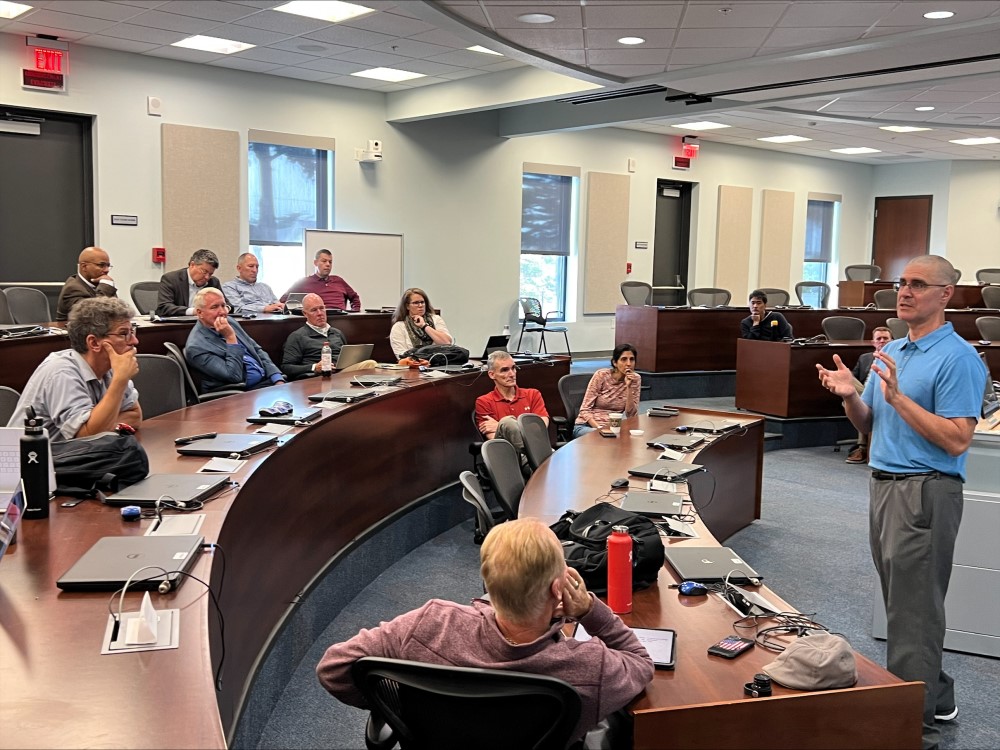Last week, Mr. John Pyrovolakis kicked off the Department of Defense Management (DDM) speaker series by talking with faculty about the importance and challenges of connecting private investors with the Department of Defense (DoD) and the defense sector.
His comments challenged some of the current optimism that adequate private funding for the latest defense technologies will solve the challenges of creating and fielding innovative defense capabilities fast enough to maintain our nation’s competitive advantage against adversaries. He gave context for how to engage the venture capital (VC) community in helping the Department of Defense address its needs.
“The venture capital community is not a silver bullet,” Pyrovolakis said. “It’s not their business model” to solve the DoD’s innovation problem – and asking them to do so is asking them to surrender their business.
Pyrovolakis himself is a venture capitalist and fund raiser. He is also the founder of the Innovation Accelerator Foundation, which promotes economic and security dominance through innovation.
He drew on his experience in this area to offer perspective on the challenges of applying private funding to defense needs: “The capital needed to do early stage, explorative, prerevenue investing into stuff that’s physical sciences or hardware-oriented (like hypersonics), you’re into a couple billion bucks. That’s a really niche point of view for a venture capitalist.”
For perspective, Pyrovolakis reminded the group that many of the paradigm-changing technologies of the 20th century–the atomic bomb, GPS, the internet, and semiconductors–were not funded by venture capitalists. Rather, they were made possible by “massive funding from the Department of Defense, [which is] not worried about quarterly earnings, or what my stock price is, or self-gain. It’s for the benefit of the country.”
We currently face a similar challenge, but against a more formidable adversary: the People’s Republic of China. Pyrovolakis reminded the NPS faculty that the Chinese Communist Party’s strategy of military-civil fusion creates an advantage over America as a funding model for defense innovation. The Chinese government also uses our own financial resources against us via direct foreign investments, and Chinese funders have notoriously bought many technologies produced by American innovators who can’t find funders in America.
Pyrovolakis shared an example from his experience in the VC community: “While I couldn’t get much interest from American venture capitalists in these broad technology areas, there were plenty of guys from China who were more than happy to fund it-- especially in hardware, electronics, and manufacturing. They’d track the stuff that was interesting, they’d wait until the SBIR grant was running out, and then” they’d approach the entrepreneur and offer to buy all the assets.
The conversation between faculty members and Pyrovolakis considered the progress DoD has made in strengthening connections between American venture capitalists and new national security capabilities. Venture capitalists are more willing to invest in early-stage, defense-focused startups, inspired by recent successes such as Anduril. Last year’s creation of the Office of Strategic Capital is actively connecting funding with companies who have prototyped promising new technologies. But the group agreed that such momentum needs to continue.
Some of this momentum is coming from current efforts in DDM and at Naval Postgraduate School (NPS) to facilitate stronger partnerships focused on innovation. DDM recently rolled out the Innovation Capstone Project, which provides a framework to intentionally connect student-faculty research teams with partners in industry and military sponsors to shepherd innovative solutions from idea to fielded (and funded) impact.
As these efforts grow and strengthen the important relationships among all players in the defense innovation ecosystem, DDM and NPS expect to see substantial, mission-focused outcomes from our students, faculty, and partners.

